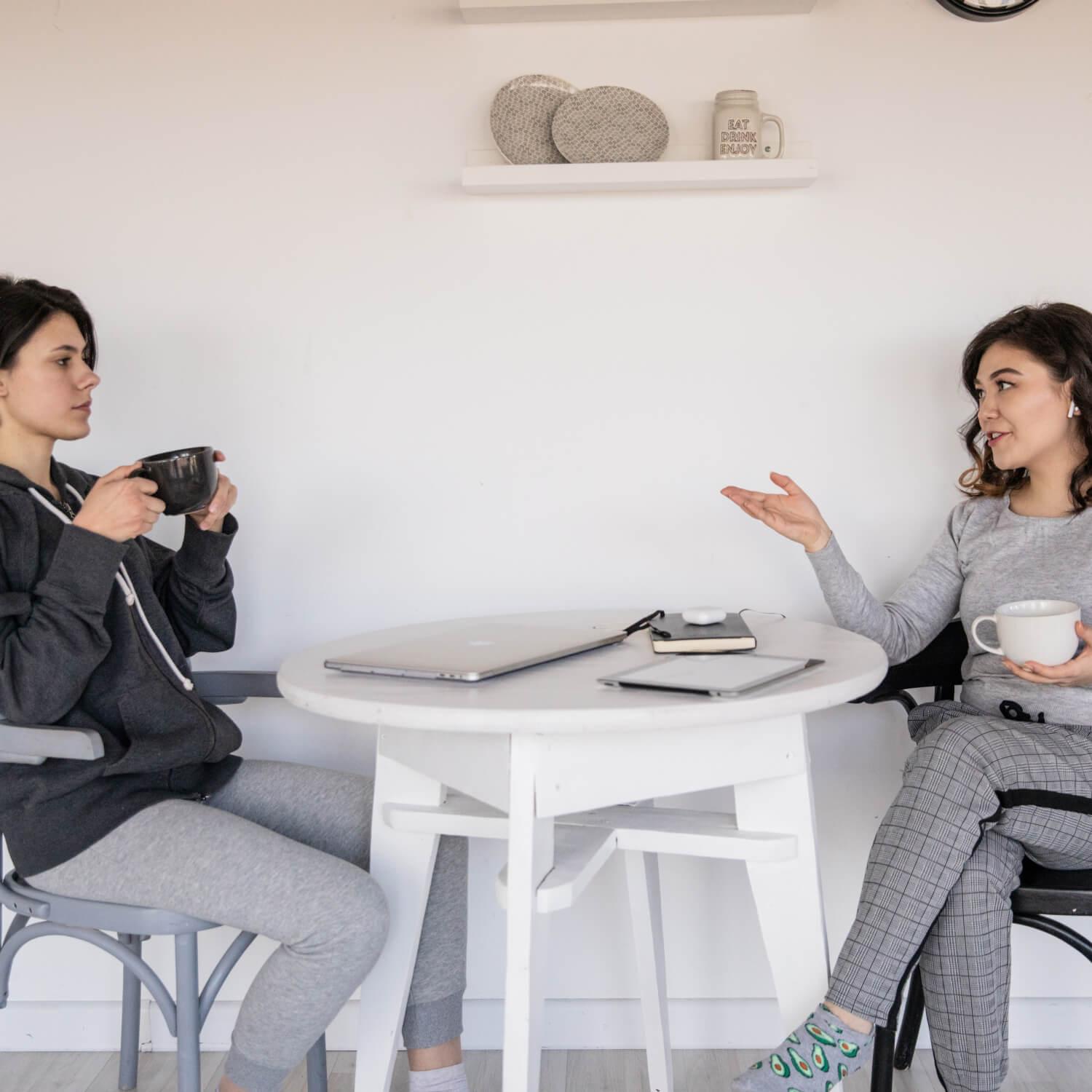How To Start a Conversation
Whether you’re an introvert who tends to shy away from people or an extrovert who feels energized by spending time with others, we all need to interact with fellow human beings from time to time.
Some may crave it more and others may seem naturally adept at the art of conversation. Regardless, knowing how to talk with people is a useful skill that anyone can get better at.
If you’ve ever wondered why it seems to come naturally to some people, don’t fret. - you too can become better at striking up conversations! With practice and some tips on how to start a conversation, starting conversations with anyone will get easier and easier.
7 Conversation Principles That Work Almost Anywhere.
Here are some basic ways to begin a conversation at any time or place.
1. Start With a Simple Greeting
The first pointer is to start simple. It really is as straightforward as issuing a short greeting like “Hi” or “Hello.” Let’s not overcomplicate this step.
However, if you’re meeting someone for the first time in a social situation like a celebration, you may want to introduce yourself and prompt the person to do the same.
2. Ask for Information
After breaking the ice with your greeting, the next step might be to ask for information to set the stage of your conversation. Let the situation guide you on relevant things to ask.
For example, you don’t have to ask for their names if you already know them or if they’re wearing name tags. If you’re at a party, you can ask how they are related to the host, or if they are enjoying themselves.
Ask about themselves, but don’t forget to talk about yourself too! If they give you their name, tell them yours. If you ask about someone’s hobbies, tell them a little about what you enjoy doing as well. A conversation is a two-way street!
It’s also important here to actively listen to what they are saying, and be able to comment or respond to their answers appropriately. If you share and interest, or hear something relevant to your life, follow up on it with more questions. It will show the other person you are really listening to what they are saying.
3. Compliment Someone
Who doesn’t love compliments? Compliments allow you to open a conversation on a positive appreciative note. It can be as simple as complimenting someone on what they’re wearing or if you’re at a party with food and drinks, taking note of a person’s choice of cocktail or hors d'oeuvres.
The most important thing about issuing a compliment is sincerity. A stiffly issued compliment can be awkward for both of you while a sincere and warm remark can make your interaction more dynamic and well-received.
4. Comment on Something Pleasant
If you can’t think of a suitable and well-intentioned compliment, say something positive and pleasant. You can say something nice about the party, the food, school, work, or even the weather.
While there’s nothing wrong with maintaining acritical eye, people generally gravitate towards positive people who have something nice to say over glass-half-empty types. Of course, this doesn’t mean you should completely ignore it when things are obviously going wrong. However, in most neutral situations, choose to go with something positive instead of the opposite.
5. Ask for Help
Again, the social context will give you clues regarding what you might ask for help with.
If you’re in a school setting, you could ask about nice places where you can hang out in between classes. If you’re new to a place, ask for recommendations about places to visit.
6. Offer Help
Alternatively, you could also offer help. As much as possible, employ this tip only when you see someone who appears to genuinely need help. If you come up to someone randomly and just offer advice out of the blue, things might get awkward. You want your offer to help to come up naturally when it’s relevant.
If someone looks lost, offer directions. Shoulda person look like they’re struggling to decide on a menu selection, mention your personal favorites and recommendations. There are countless ways to help once you learn to become more attentive to the needs of others.
7. Mentioned a Shared Experience
Again, contextual clues will come in handy if you’re looking to bond over a shared experience because you first have to identify what that shared experience is. If you’re just about to strike up a conversation with someone, notice if they look bored, happy, excited, or nervous. Or perhaps that person is wearing a t-shirt of a rock band that you’re a fan of. Small details like these can help you learn a bit about someone even before the first word is said.
Once you identify possible common ground, you’ll have a much better chance of talking to them about something that matters to the other person. You can then commiserate, validate, or share excitement about your shared experiences.
Opposites may attract but when you’re first getting to know someone, commonalities are invaluable tools for building rapport.
8. Talk About the Weather
Sure, talking about the weather is an overused tactic but surely no one in polite company would outwardly reject someone who’s obviously trying to make small talk. The weather is a great topic because it isn’t too controversial and everyone has an opinion about it.
So, if you ever feel like you can’t think of anything suitable to say, start with the weather and go from there.
Tips for Engaging Conversations
Because how you say something is just as important as what you’re saying, here are some tips for having engaging conversations.
Listen and Express Interest
You know what they say: interested people are interesting people. So, show the person you’re talking to that you’re interested in what they have to say. Make it a point to validate what they’re saying by giving them appropriate emotional responses whether it’s by laughing, sympathizing, or expressing shared emotions.
Talking to someone who is emotionless and doesn’t provide feedback can be frustrating and unnerving. Provide genuine responses that show you’re listening and interested in what the other person has to say.
Strike a Balance
Once you’ve noticed that the person has paused for a couple of seconds but hasn’t asked you a question, feel free to say what you think. But always strike a balance.
Don’t speak too fast or too slow, talk too loudly or too softly. In the same way, don’t hog the conversation and talk for more than a few minutes straight. Don’t ask for or give too many details. In the same way, avoid being too vague.
Body Language
Aside from listening and paying attention to what the other person is saying, another way to show them that you are paying attention is by using body language.
Keep eye contact, but don’t forget to blink. Nod when you agree with something. Smile when they mention something you like. Look serious when you are talking about serious stuff, and relax your face and body if the conversation is casual.
Use hand gestures in moderation, and mind your physical distance from each other. Keep a respectful distance of roughly an arm’s length if you’re with a new acquaintance.
On the flip side, pay attention to their body language as well. If they don’t look you in the eye, nod, or smile, it might be time to tell them thanks for their time and then leave them alone. If they react enthusiastically to one topic, that’s a sure sign you can talk some more.
Avoid Uncomfortable Topics and Talking Too Much
Resist the temptation to talk about topics that tend to generate very strong negative reactions or no reactions at all. Topics like politics are usually best reserved for classroom discussions or with people you’re already very familiar with since arguments can be more easily de-escalated.
Also, avoid discussions that are too personal like health issues or money matters. Skip talking about romantic partners or things you don’t like. Overly mundane things like what time you woke up and what you ate for breakfast might not be interesting to the other person so just keep those in your back pocket for another time.
Conclusion
We hope you were able to pick up a few pointers here and there and that you’ll be trying them out soon. It’s totally fine if you forget some things along the way. You can always come back to this later for a refresher.
Remember that nobody was born an expert conversationalist. Even the most sociable adults will have a few false starts and awkward conversations with people. After all, people are unique and you just have to find the people you “click” with. But finding other people won’t happen unless you go out and have conversations.
It’s usually a good idea to seek out the people you have a lot in common with. This usually gives the assurance that you’ll have a lot to talk about. But it’s also never a bad idea to expand your horizons and be curious about people who seem different from you. After all, we can learn more from our differences than our similarities.
If you’re just starting out, be patient with yourself and realize that not all interactions will leave you with feel-good fuzzy feelings. It’s absolutely okay to have some awkwardness now and then as you learn what works for you and what doesn’t. Like all skills, being an excellent conversationalist only happens with time and practice so make it a point to start conversations with different people every now and then!
© 2022 Talking Point Cards.
For all general inquiries, please contact us at support@talkingpointcards.com







